Differentiation and Accommodations: Buffet Style Learning
 By Peggy Veal, French Teacher & World Language Department Chair, STEM School and Academy, Highlands Ranch, CO.
By Peggy Veal, French Teacher & World Language Department Chair, STEM School and Academy, Highlands Ranch, CO.
Growing up in France, I was not really familiar with the concept “all you can eat” buffet restaurants until I came to the US. I used to wonder why anyone would want to own such a restaurant, and encourage people to eat until they felt sick, or why anyone would want to partake in such a meal concept. When I became a mother, I began to get a better grasp of their appeal. I am a mother of 3 daughters. They are 15, 10 and 10 (my youngest are twins). I am the cook in the family, and though I enjoy cooking, making meals for our family can sometimes turn into a logistical nightmare. I have one daughter who loves to eat, and one who eats like a bird. My husband is a meat eater, and my teenager would rather eat a whole head of lettuce. Doesn’t this sound like a typical classroom? If only students could all just learn the same way, there would be no need to turn your classroom into an “all you can eat” buffet style learning environment!
As a parent/teacher, it is my job to make sure everyone eats/learns enough, and gets what they need. This means filling one daughter’s plate more than the other, and balancing out the meat and veggies. Is it fair that I don’t expect them all to eat the same quantity of the same food? Not only is it fair, it is the only way for everyone to stay sane! The same goes for your classroom. John may need more practice to get a certain concept, but Kathy may get it the first time. Differentiation in this situation would recommend that both students should not have the same homework (in quantity or in content). Kathy may be a great note taker, but Brendan may have severe dysgraphia. Differentiation here would mean that the teacher would present different ways for the students to access the same information.
It seems so overwhelming to create different lesson plans, homework assignments and assessment in order to accommodate everyone. This is where the Buffet Style Learning concept comes into play: what matters is that all the dishes are on the table so everyone can scoop up what they need onto their plate. As long as you provide the dishes, it’s ok to decide to give each one what they need. In your classroom, not everyone will benefit from homework, not everyone will be able to take great notes, not everyone will be able to present in front of the class, not everyone will be able to memorize. I know, it makes it so much harder for us teachers, but if you fight it, you will find yourself miserable, and your results will be poor. Your students will resent you, and you will be spending countless hours justifying yourself in emails and meetings with parents and administration, trying to explain why your way is best.
So, without turning your classroom into a full-on buffet, multiplying your tasks and turning your lesson planning into a mess of multitasking insanity, how can you successfully offer choices and provide what each student needs? How can you make sure your “menu” contains enough variety to satisfy everyone and provide the proper documentation for your administration? The first step will be for you to accept the idea that fair does not mean equal. You will need to look at your classes as a group of individuals and no longer as a unit. In our teacher lingo, this is called “differentiation”. It doesn’t mean that you can’t hold all students accountable for the same results, but it does mean that you have to be willing to adjust, and accommodate to their learning styles and provide assistance based on their specific needs. It’s a work in progress, and I am still finding new ways to do it more effectively, and without causing myself extra work. I hope to share with you some of my ideas and perhaps encourage you to let go of your own fountain pens and color titles, so that your students can feel that you are setting them up for success.
“Buffet-style learning environments reduce (or eliminate) the number of lectures and/or class meetings, replacing lectures with a variety of activities supported by interactive software and more individualized assistance. Such a strategy is not only more effective in dealing with learning issues but also more economical.”
(“Maximizing the Educational Benefits By Using A Buffet Style Of Teaching”, Samia Massoud, Prairie View A&M University)
TWO DIETS: THE 504 AND THE IEP
Let’s briefly talk about the two main categories of legal accommodations teachers must provide:
The 504 plan is a legal document that states the need for accommodations for a student based on a medical diagnosis. These accommodations can be as simple as preferential seating, or the opportunity to go to the bathroom without restrictions.
The IEP terminates upon graduation from high school. It is a good idea for students/parents to request a reevaluation prior to high school graduation if the student’s IEP or 504 Plan has not been updated. This may serve as documentation for accommodations at a university or college and possibly avoid the expense associated with updating diagnostic testing to support accommodation requests.
In contrast to public pre-12 education where students can be identified by the school, individuals must self-report in order to receive accommodations at the college or university level.
College students with disabilities are supported under the Americans with Disabilities Act (ADA) and Section 504 of the Rehabilitation Act.
My own daughter is type 1 diabetic, and has had a 504 for several years. Her 504 states that due to her diagnosis as a type 1 diabetic, she should be allowed to go to the nurse or the bathroom upon request. This request cannot be denied under any circumstances, because it may impact my daughter’s ability to treat her blood glucose level (high or low). Teachers are asked to inform themselves at the beginning of the year on the specific accommodations that a student’s 504 lists, so that the student can be successful. The 504 is usually revisited on a yearly basis, to make sure that the needs have not changed, and to ensure that the accommodations are still appropriate for the student. In the example of my daughter, now that she is a Sophomore, we (her parents) have decided that she no longer needs to see the nurse to test her blood glucose. She can do this discreetly in the classroom to avoid loss of instruction time. When we met with the Special Education Staff regarding my daughter’s 504, we made this quick change on paper and this was communicated to her teachers.
The 504 plan is designed to avoid discrimination based on a student’s disability. It is important that all teachers respect the accommodations listed in a 504, whether or not they agree with them.
The main difference between a 504 and an IEP stems from the legal Act that they originated from, (see links below).
I prefer to think of it as follows: a 504 plan is designed to help a student who has a disability that interferes with the learning in the classroom, whereas an IEP is designed to help a student with a disability that impacts the student’s ability to learn in the classroom. Also, a 504 does not usually define the student’s learning goals. It only lists ways in which the student can be accommodated to be successful.
A parent’s guide to Section 504 in public schools
504’s versus IEP’s
At the beginning of the school year, when a teacher receives their portfolios of 504’s and IEP’s, it is recommended that they put together a practical guide to keep track of the specific accommodations needed.
I like to make an “accommodations flipchart” that I can refer to anytime I give an assessment, prepare a new seating chart, or assign a project. It helps me remember which students need extended time, preferential seating, chunking of assignments, access to technology etc.
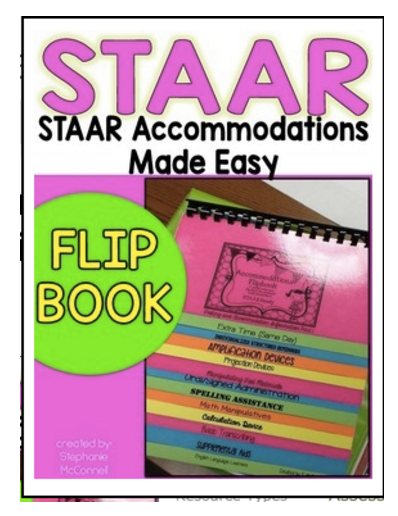
I would recommend Stephanie McConnell of Principal’s Accommodations for Students with Disabilities Flipbook BUNDLE , available for $6.00 on Teachers Pay Teachers. Here is the specific link to it.
While hers is based on Texas’ education agency, you can use the idea and adapt it to your needs.
Instead of getting yourself overwhelmed by all the specifics of each child, remember that as long as you display a variety of options, each child will find what fits them. The beauty of the world language classroom is that everyone is learning the target language from the start. This puts everyone at the same bottom step of the ladder, but based on the child’s learning abilities and style, some may be at a disadvantage quickly if you don’t diversify your teaching methods.
This can be done via a comprehensive teacher website where students can access everything. On my school website I host anything from my class syllabus, to guided notes, every single handout I pass around in class, a detailed calendar of the class activities, and even student example of assignments. I do this because it helps me stay organized, but mostly because it is how I document the options I offer to students.
“Sophisticated course-management software packages such as WebCT and Blackboard, however, enable faculty to monitor student’s performance, track student’s time on task and overall progress, and intervene when necessary on an individualized basis. Many types of communication can be automatically generated to provide needed information to students and encourage their participation. Regular weekly, computer-generated emails can inform students about their progress and, if necessary, suggest additional activities based on homework and quiz performance.”
(Samia Massoud, Prairie View A&M University).
My school uses a platform called CANVAS. Here are some screenshots of what it looks like:
Here you can see that I organize my curriculum in modules. Because we are in semester 2, we have already completed 3 modules.

Here you can see the details of what I post within a module. It includes links to note sheets, to class work, to rubrics, and the warm up questions. This way, students who were absent, or need to review what we did in class can access any and all the information I presented during the class. This also allows me to tell parents that THEY have access to any of the content I teach, so they can clearly see what is happening in my classroom each day.
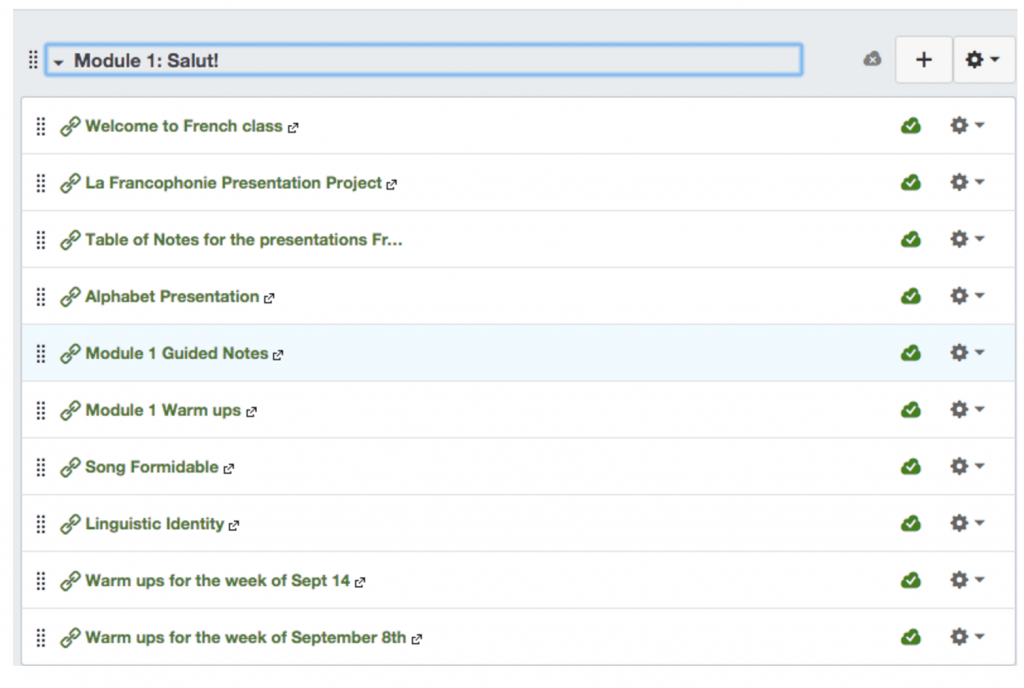
This screenshot shows the assignment tab for a module. It shows the categories of grading and each assignment that I am going to give for the module.
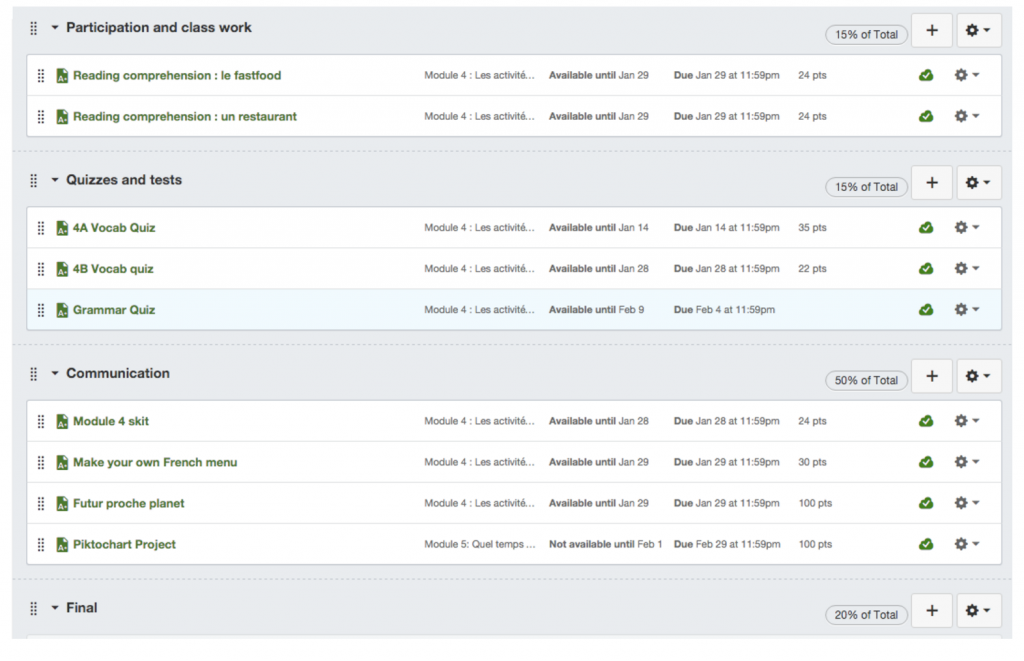
This picture shows the details of one assignment (showing the link to a google document with instructions/the points possible for the assignment/the date it is due/and how I expect it to be turned in).

As you can see, there is nothing left to the imagination for students or parents in terms of what is happening in my classroom.
I know this represents some upfront work, as does anything that is effective use of technology, but the rewards are worth it. Any student who needs accommodations for note taking, access to review materials etc…. can access those independently or with a parent / tutor / counselor inside or outside of school.
RECORDING LESSONS
About two years ago, the “flipping” concept became very popular in education. I decided to experiment with it, and started using Ink2go, (http://ink2go.org/). I never felt that language learning particularly lent itself well to classroom flipping, but I started recording some of my grammar lessons to see how my students would respond. I posted them on my website and told my students to check them out. After about a week I was shocked to find out that, while not all my students were watching them, some were watching them up to 5 times! Looking at specific students, I noticed that they were students on accommodations. That was all the evidence (and documentation!) I needed to continue posting. them. Remember, it is not about the majority, it is about what each student needs!
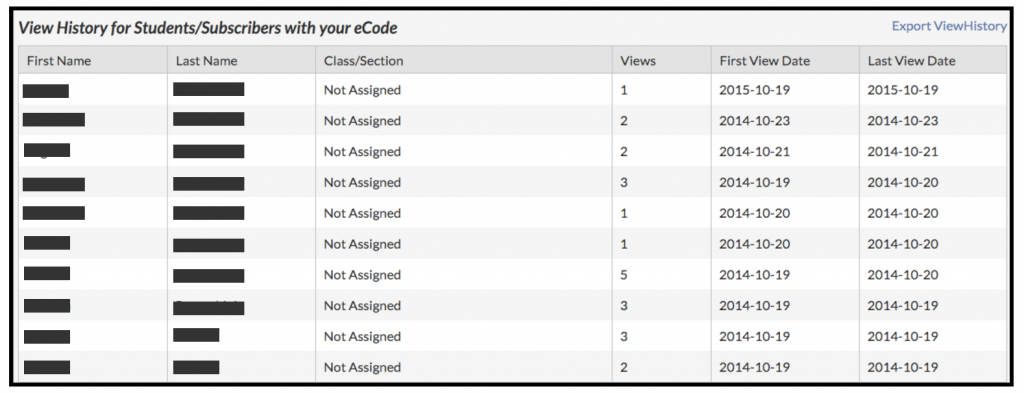
Here is a link to one of the videos I have made. As you will see, they are far from fancy, but they serve their purpose. My students can watch them in their entirety, or watch just what they need to review. They can fast forward, rewind, and pause to review exactly what they want. Not only can they do it, their parents/tutors/counselors can do it with them. I like Ink2go because the software allows me to show my face in just a small square in the corner of the page, so the focus remains on the lesson, but it is not impersonal.
APPETIZERS
You can differentiate and accommodate students right from the start of your class, with a tiered warm up.
Last year, during one of the observations my principal did for my yearly evaluations, she commented on the fact that some of my students seemed to be done with the warm up quickly, while others seemed to struggle considerably to even comprehend the question. To be honest, I was a bit flustered that I was being asked to reconsider the format of my warm ups. After all, for me, they were a great way to get students on task at the beginning of class, while I took attendance and dealt with transitioning from the previous class. As world language teachers, we often have multiple preps and need more than 5 minutes of passing period to recover from teaching a level 1 class, followed by an AP class!
Later on that year, I observed another class (not even a world language class!), and saw that the teacher had 3 questions for warm up. I began to think that perhaps I could tier my warm ups into 3 levels. Here are the instructions I give students at the beginning of the school year:
Each day the warm up contains 3 level question. It may be worded in French or in English.
Ex:
1- What is the difference between tu and vous?
2- Use “tu” in a sentence to ask someone how they are doing.
3- Use vous in a sentence to ask someone what their name is.
If you can complete all 3 questions, it means you have MASTERED the topic we have been learning.
If you can complete 1 and 2, it means you are PROFICIENT, but need a little more practice to MASTER the topic.
If you can complete 1, it means you are PROGRESSING in the MASTERING of the topic, but you need to study more and possibly ask more questions about what you don’t understand.
The result of doing this has been remarkable! I give my students about 5 to 7 minutes to complete the warm up. Then we go over the answers. I never ask students which questions they were able to answer. I let them self assess. I do, however, ask the class to reflect on their ability. About once a week, I will ask the class “how many times this week were you able to answer all 3 questions on the warm up?” or “did you review the questions you had not been able to answer?”. I also often use the same warm up questions on tests and for interpersonal speaking assessments. Students know this, and it makes warm ups more meaningful.
As for accommodations, having a tiered warm up has allowed me to allocate the following to my 504/IEP students:
→ students who need extended time or additional instruction can answer only 1 out of 3 questions (they can decide which one it is)
→ students who need access to all notes and materials have access to ALL of the warm up questions via a link to the google slides containing all the warm ups (here is an example : https://docs.google.com/a/stemhigh.org/presentation/d/1lW6UDRoGc_YY26L3PrYOTo7KJCnhHkcsni0LWXSVLvg/edit?usp=sharing)
ZAPTION
If you don’t like recording yourself, here is another way to use pre-made videos to assess your students or provide review of the content. This is great to use as formative assessments or as a way to provide reinforcement for students whose 504 or IEP requires more “chunking”. Furthermore, Zaption provides a very comprehensive post analysis of the students’ answers, which is great for documentation of the accommodations. Here is an example of one I used in class:

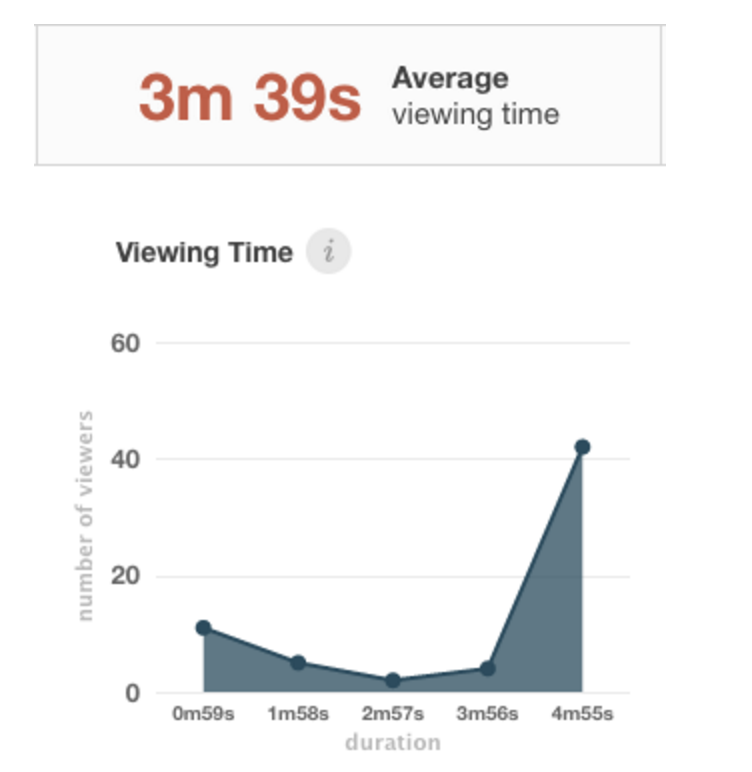
The video I used is from the French documentary called Humans. I felt that it was a perfect video to review the Passé composé. As you will see, I inserted questions throughout the video (a very easy drag and drop process on Zaption). Students viewed the video in class (we have a one on one computer classroom), but it could be done for homework or in a computer lab at school. Zaption’s analytics tab offers graphs that show averages for student performance (see below), but also individual results.

With these analytics, I am able to see how my 504/IEP students are performing, without making it obvious in class.
It allows all students to function at their own pace, skip forward, backwards as needed.
Zaption also offers students the ability to slow down or speed up the speech in the video (see the 1x sign at the bottom left of the video, below the audio track). My students find it extremely useful. They have said that it helps them not get overwhelmed and frustrated during the video. This is a great example of accommodation for students with processing disorders and anxiety. If we truly have the growth mindset in mind in our classroom, students should be allowed to experiment and fail during assignments, in a way that is not threatening and promotes effort. Students will want to keep striving for success if they feel that they are given the opportunity to do better each time they try!
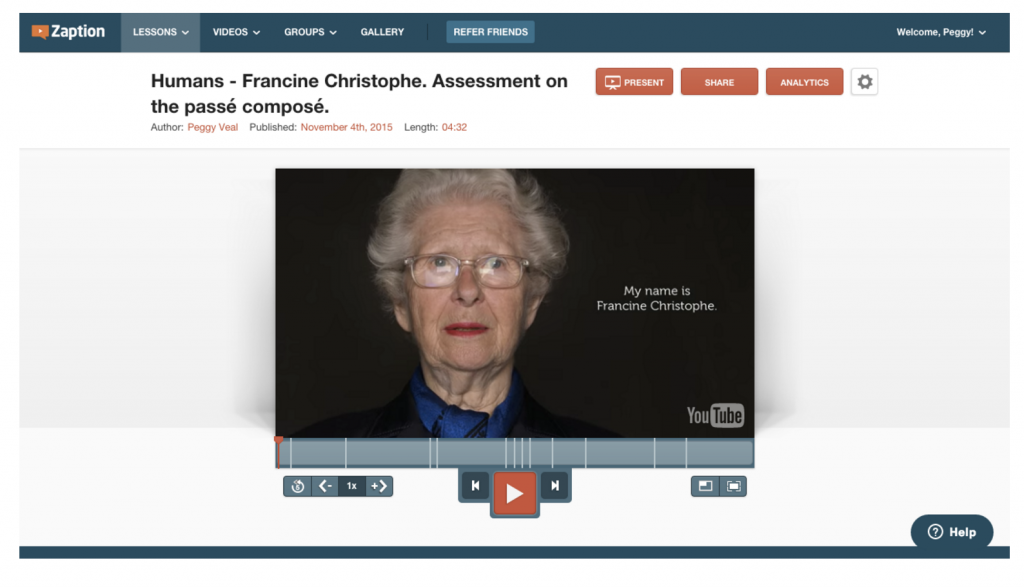
SPEAKING OF RECORDINGS…
Technology does not have to be fancy to be effective. Sometimes, the old fashioned recorder is a better investment than a complex computer software. After seeing them in action at Cheyenne Mountain High School in Colorado Springs, I decided to invest (with department funds) in a set of 30 recorders for the classroom. Here are the ones I chose. They are small, compact and contain 5 folders (one for each of my class periods!) that students can record on. I have never run out of room on those recorders, even with every single student (150 total) using them the same day. I choose to give my students the option to perform their skit in front of the class OR to record it on one of the recorders. Surprisingly, most students still opt for the performance, but I usually have about 5 students in each class who opt to record. One of them is a student on an IEP for severe stuttering. The IEP in question states that the student is exempt from having to present in front of the class. The recorders have been a very simple solution, and because it is an option offered to the whole class, there is no need to filter their use. Out of the set of 30 recorders, 5 of them stay in the special education room in case any of my students need to record during a test that requires a time extension. Since then, the special education teachers have asked to use them for student presentation in other classes for 504’s / I.E.P’s related to autism, emotional disturbances, and speech and language impairments.
PEARDECK
The next resource I would like to share is www.peardeck.com. Peardeck has essentially taken away the need for preferential seating in the classroom. It has also basically replaced 3 essential items in my classroom:
- the white board
- the set of clickers I used to use daily!
- the document camera.
With Peardeck, you can upload an existing PowerPoint or google slide presentation you have made, (or create one directly on the website), and present it to the class. What makes Peardeck a great resource for differentiation is that once you go into presentation mode, your PowerPoint or google slide instantly appears on ALL of your students’ screens. Your students no longer need to look at the board to follow along. As you progress through the lesson, you have the ability to insert questions (anything from a yes/no to a “draw on your screen” answer type) for your students to answer. (See the “Getting started video here).
Once the lesson is finished, you can grade each student based on their answers thanks to the analytics the website provides (see below). In the lesson shown below, the class was doing a reading comprehension assignment. After the assignment, I gave students 2 grades: one grade for engagement (was the student answering the questions, and participating or not) and one grade for correctness (where the answers complete and correct). Because the analytics are student specific, you can document each student’s progress and engagement. You can actually show parents exactly when and how their student answered a question (or when the student was disengaged or didn’t know the answer). I cannot think of a better way for a teacher (and a parent) to get a clear picture of and document how a student is doing in class (short of videotaping them!).
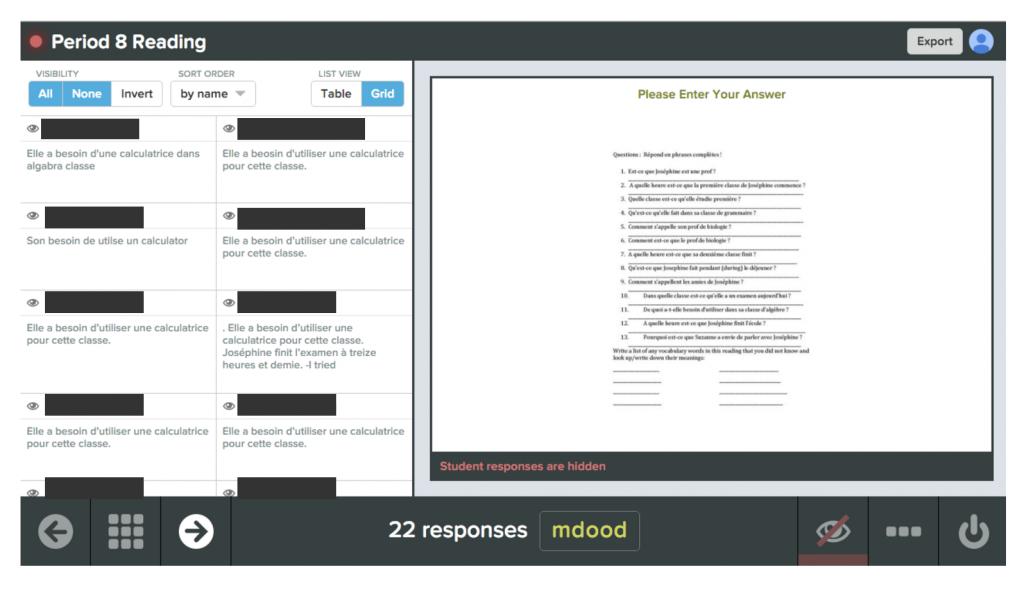
BACK TO THE BUFFET
There are times when taking the family to an all-you-can-eat buffet is the only way to keep your sanity. The same goes for differentiation in the classroom. When I attended the latest EdTechTeam Colorado Summit featuring Google For Education in Boulder, I realized that Google has come up with their own “buffet style assessments”. I am still experimenting with it, but I thought I would share it with you and give you the links to the instructions Google has made available for teachers to learn this new concept.
It is called Branching or Adaptive testing. The concept of branching allows for flexibility in the delivery of an assessment. It determines which questions each student will be prompted to answer, based on their abilities and their answers to previous questions. Branching/Adaptive Testing is already used in national testing. All you have to do is use the “go to page based on answer” check box when creating a question on a google form.
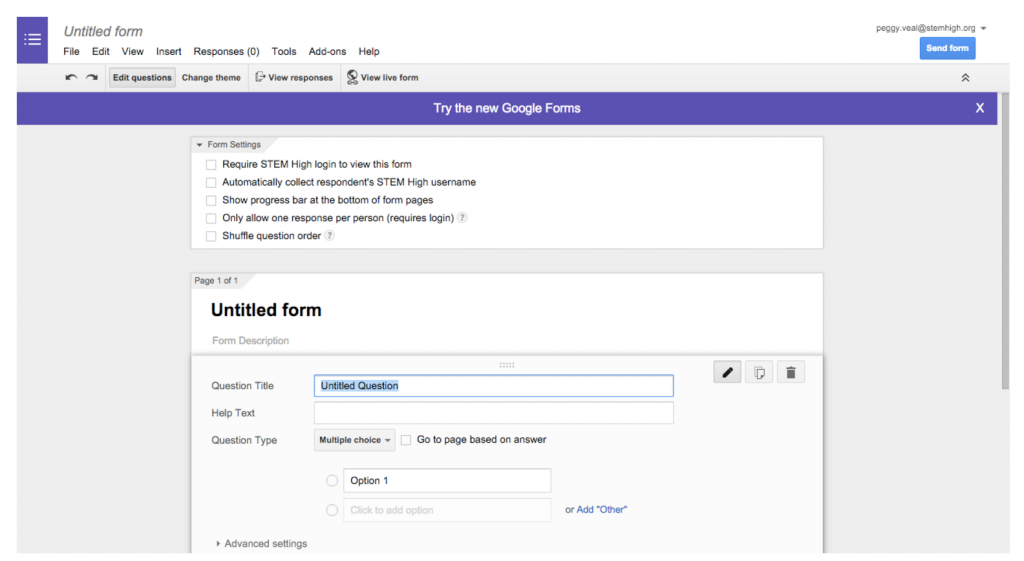
Here is a wonderful set of instructions to get started (courtesy of Kasey Bell)
DIFFERENTIATION IN READING
Students have different reading abilities, and this is true in their native tongue as well as the target language you teach in the classroom. With Newsela you can adjust the lexile level of the reading you assign. It does not change the content of the article, but allows the student to access a lower or higher lexile of the same article. Newsela also offers questions to go with each article so you don’t have to create your own set of questions. Newsela exists in Spanish, but not yet in French.
If you want to design your own guide for an article, there is a great google add-on called Scrible. It is a chrome extension that allows you to annotate an article and insert questions or comments. With Scrible, you can guide your student through their reading assignment and simply share the link with them when you are ready to assign the reading. Here is an example.
MENUS (This Time I Mean Literally)

As the expert, you know what your students’ main objectives are for each unit. Once you have communicated those to your students, you can offer options for them to reach those objectives, but keep a certain amount of control of the path they will take with those options. A great way to do this is with the tic-tac-toe concept. In this concept, students have to pick 3 assignments from a grid of 9 choices, however, they all HAVE to complete the assignment in the center (the non-negotiable), in order to form the tic-tac-toe. The tic-tac-toe below was made on google doc, so I was able to insert links to rubrics and detailed requirements.
Illustration of the TicTacToe Concept
To learn more ways to create TIC-TAC-TOE menus and other types of menus, check out Casey Bell’s website!
THINGLINK
I like to have students create posters in the classroom, but I find that using technology as an assistive tool is a great way to cater to students who are not great artists, or who are not confident with spelling or handwriting. I have used Glogster in the past as a way to create online posters, but I have encountered too many technical issues with the website.
Either it would freeze or not save my students’ work (talk about frustration!). Thinglink allows students to use a background picture and add markers on it to insert information (in the form of writing, recordings, links, etc.). Below is an example of a project that included culture and the past tense (my students needed to discuss the invention of a famous deceased French inventor using the preterit and the imperfect). In the example below, the student chose Coco Chanel, so she placed a picture of Coco, and added markers. When you hover over a marker, it reveals the information she put under it (illustrations of Coco’s designs with a few sentences explaining them, written by the student herself).
The student presented her Thinglink to the class as well, which served as a “presentational” assignment.
Thanks to Thinglink, I was able to have students use alternate art found online, and the text was typed (great for students with dysgraphia), and some even included recordings (great to show that students can present remotely instead of in front of the class).
I used the classroom version of Thinglink, so that I could access the students’ work from the beginning, and provide feedback as the students continued working on them. This is great for students who need specific reminders to stay on task. As with any assignment you do online, it is easy to take screenshots and email parents evidence of a student’s lack of progress as well.

REMEMBER…
Many students struggle in the classroom due to the following pre-conceived ideas that permeate in the classroom:
The notion of “prior knowledge,” or of what students are supposed to know by the time they arrive in our classrooms. In world languages, this can be illustrated by the struggles a student may have learning how to say the time in French because they do not know how to read a clock! This means that as teachers, we must not assume that our students master the basics before we introduce them in another language. Assessing a student on numbers by giving them additions or subtractions may give false results (the student may write the wrong answer because they calculated wrong, not because they do not know the words in French). Instead of assessing with fundamentals, we must think of differentiated assessments based on situational problems, with authentic situations that a student may be faced with in another country (for example: a phone number, or a reservation number) so that our students do not feel penalized for a failure related to another lack of knowledge.
Refusal to build imaginative content based on culture. This can be an easy shift if you implement the 90% target language rule in your classroom. Students can learn manners, facial expressions, personal space, and problem-solving concepts from your target culture simply by observing you! As you proceed through the backwards design to prepare your unit, think of the deeper culture that you can teach throughout the unit. For example, if your unit is on FOOD, think of the communication styles involved in ordering food, the notions of courtesy or manners involved around meals in the target culture, notions of time involved with food (how long does a meal take, what time does each meal occur), attitudes towards food in the target culture, approaches to raising children to appreciate many types of food in the French culture, etc.
I have found that even the students who struggle with memorizing vocabulary, can remember words much easier if they are associated with pictures and cultural anecdotes.

TEACHING TO THE TEST
At the beginning of the year, one of my French 1 students asked me: “how much French will I be able to speak by the end of the year?” I tried to answer his question by listing the various unit objectives that we would be reaching throughout the year, but he interrupted me and said “I use DuoLingo, and it gives you a percentage of how fluent you are as you are learning the language. What percentage will I be at the end of French 1?” I wasn’t sure what to answer. As teachers, we have to give tests to document progress but do we ever really give a student a fair idea of where they stand in their progress of the language learning? When you travel to a foreign country, you can quickly assess your ability by how much you can converse with the natives. I feel that we need to make our classroom as close as possible to being an authentic space where students can assess their own progress through authentic conversations versus tests that only give them a grade.
GROWTH MINDSET AND LEARNING “A LA CARTE”
Difficulty is a normal step in learning, but when the difficulty has been identified and specified in a legal document (504/IEP), it is the teacher’s responsibility to offer the proper accommodations for students. For this reason, providing an emporium of learning options represents exciting potential. Once you have identified the objectives of each unit, you have 4 main steps to follow to create your “A la carte” menu:
- Assess each student’s knowledge level and preferred learning style.
- Provide an array of high-quality, interactive learning materials and activities.
- Build in continuous assessment to provide immediate feedback.
- Offer appropriate, varied human interaction throughout the experience (cultural connections).
As a teacher, it is difficult to not feel defensive when talking about accommodations, as if all of the activities and gimmicks we provide in the world language classroom were not enough already! When I feel overwhelmed, I try to remember this quote by Molière: “The greater the obstacle, the more glory in overcoming it.”
We are teachers, professionals, learners, parents, and most of all collaborators. We know our content area like experts, and if we can hold on to our curiosity and passion, we can find more ideas to help every student learn. If you have ideas for differentiation and accommodations in your world language classroom, I would encourage you to share them. We can all use them! I would love to discuss this topic further with any of you, and develop a resource that we can all access when we need support and suggestions.
I can be reached at peggy.veal@stemhigh.org


It is very interesting article, explanation of technilogies is easy to understand. The different resources are really valuable and would cater students’ needs. I believe using these resources will improve the learning and teaching style.
I hadn’t heard before about the concepts IEP and 504. But those challenges help us understand better some aspects of the students who sit in front of us and not just for the one who are on the list. There may be more students who could receive benefit of the accommodations of the activities and programme. I mean, how they learn and what would be better for them.
The concept is very useful and interseting.
I did not understand the meaning of “Refusal to build imaginative content based on culture” under the section “Remember”. Can someone explain please?
so interesting article.
Nice article!
Many useful tips and tools, thanks a lot!
Awezome article and complete!
It is a very useful article where teachers should investigate and try to you the different resources available. The different resources are really interesting and different and would cater all the needs of students. I believe using these resources will empower the learning / Teaching style.
It is a very useful article that has many different and technological resources in all areas where teachers should try them to empower their learning and teaching style.
WE can mention many websites thatcan help us to enhance students’ attention and ha ve a variety of learning styles. We as teachers have to start exploring diffrent apps so we can have a rainbow of activities
Does anybody know an app that would replace Zaption?
Thank you
H5P’s interactive video, Playposit, Edpuzzle.
Inspiring article
Excellent article.
I hope to find something like Newsela for French language learning but all of these tools sound useful. The differentiated learning will help ELL students as well. Great options for students to work online when they’re not in the classroom.
Scribble is something that I must try! Since it is a Chrome extension, it should not be too difficult to install.
Great practical ideas – the three questions along with many web based LMS platforms
Some of the steps, concepts and ideas I have used and heard about over the years. This article and the prior content was a great refresher. I love the buffet style concept for differentiation
Quotes and graphics I like down;
Fair does not mean equal
It is not about the majority but about what each student needs
The greater the obstacle, the more glory in overcoming it.
The Cultural Iceberg
Ideas I like – Give students the option to record or to perform in front of the class.
Tic Tac Toe Idea
Thank you!
I love this article so much! It is very inspiring and useful! All the quotes you listed and ideas you picked are exactly what I love most!. Thank Peggy and you! Cheers!
Great practical ideas – the three questions along with many web based LMS platforms
Some of the steps, concepts and ideas I have used and heard about over the years. This article and the prior content was a great refresher. I love the buffet style concept for differentiation
Quotes and graphics I like down;
Fair does not mean equal
The greater the obstacle, the more glory in overcoming it.
The Cultural Iceberg
Ideas I like – Give students the option to record or to perform in front of the class.
Tic Tac Toe Idea
Thank you!
Extremely useful content in terms of providing blended learning tools, elaborations and authentic examples. The article connects to customized options for instructors from different regions and cultures.
Thank you!
Thank you Peggy! What a wonderful wealth of knowledge here. Really appreciate your sharing so many different ideas and software and giving examples of how they are used in your context. Though I am not teaching a language but the tips and ideas can definitely be applied and adapted. Your willingness to share and build up others in the teaching community is very inspiring. Awesome, bless you!
Thank you for reminding me about the three tiered warm up!!
I see this as being useful as I try to build community, practice peer-to peer support protocols, and foster independent learning/metacognitive insights during synchronous virtual class meet ups.
I really enjoyed this article. It’s important for instructors to really consider the needs of each individual student. I find that kinesthetic learners, for example, are often left by the wayside in the FL classroom. Offering a variety of teaching activities and approaches, in addition to actively checking in with students on a weekly basis, can make a huge difference in students’ proficiency levels.
This is the best article on differentiation that I have read, to include the suggested activities.
Wow! This is a good article where every teacher can reflect and great resources. Thank you
There were so many great ideas here. I’m in my second year as a Spanish teacher, and I’m a bit overwhelmed by feeling like last year was a lot of winging it. I am committed to the idea of offering lots of options, and I know that this year will require tons of work to collect the options for the variety of learning styles of my students, but I think it will be worth it when I think about how very shy some student are and how very outgoing others are. Thank you!
Wow…excellent article…
The analogies in this article made it very easy to understand!
The cultural iceberg concept is very useful.
Thank you so much! I found the ideas in the article easy to do and very useful.
Wow, very interesting concept and great information on some of the available technological tools. Thank you.
thank you madam
it is an insightful article which surely help the teachers to empower themselves
Thank you for sharing these resources with us! I look forward to enhancing my teaching by using them!
That was an enlightening article! Thank you for all that information and the suggestions based on actual experience.
I found this article very interesting and useful. I agree with the idea of using authentic materials in our classroom because it gives students the opportunity to experience cultural aspects embedded in the language.
Wow! What a great way to learn about differentiation and accommodation! Our district does not offer training for language teachers so we are often scrambling to figure out ways to meet our requirements. This article is an excellent “training” for our language teachers. Thank you!
i love the 3 warm up questions
Agreed. I wrote them down. I will definitely use them and adapt them for other units.
I love all of your ideas, I really appreciate how you showed us what everything you talked about looked like, you had links to show examples and to give us steps to follow, I am excited to try some and will definitely be contacting you as I proceed with the creation of my hybrid classroom. Thank you for sharing your knowledge.
Really liked the cultural iceberg illustration. Also the many, specific technology tools you recommended. Thanks!
I loved this article! I have so many ideas. 🙂
Thank you for sharing all of these resources!
The Tic Tac Toe assessment option is a wonderful idea. I like the non negotiable assignment, but the ability of the student to choose 3 assignments out of the 9. Thank you for sharing these great ideas of the Buffet Style Learning.
Very useful article, and resource for different concepts. Thank you for sharing your knowledge.
Very useful article. I like the idea of thinking in terms of a menu. I also like the tic-tac-toe board concept.
While reading this article it made me realized that accommodation and differentiation are both essential to learn.
Myka, well said, that was a good reminder to me as well while reading the article.
This is such a good article where every teacher and parent can reflect. The information discussed are timely and essential especially with kind of educational system that we have.
Thank you, Madame Veal, for sharing the resources you use to differentiate instruction. The details provided in your article are very helpful!
I really enjoyed your article that includes a lot of practical and useful information that could help me improve my teaching. Thank you also for the quote by Molière! I will transmit it to my students.
I really like the tiered warm ups. That is something I can really use at all levels.
Excellent article with so many personal, anecdotal, professional, and situational examples. A treasure trove toolbox! Thank you Madame Veal.
Great article, eye opening. As a mother I experienced this first hand. My son had a different learning style that was never accommodated hence his hate for schooling and lack of progress. Finally as he reached college and was shown different styles, different assignments, difference was celebrated, not punished, he excelled.
Unfortunately as an instructor of a foreign language , I could not find any of the tools mentioned in the article , available in the language I teach.
Great article and great resources. I will def put into practice some of the resources suggested in this article. Thank you so much!
very useful article. I think I should share this with my colleagues to learn
so interesting article and useful !
It is very succesful example of being a mother and being a teacher! They fit eachother by means of giving the essential nutrients either your students or your children.
very interesting article! i am going to check out some of the websited mentioned in this article! thank you!
The cultural iceberg concept is very useful.
The cultural iceberg concept is very useful.